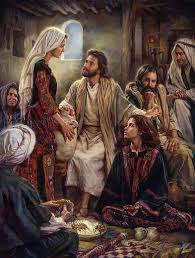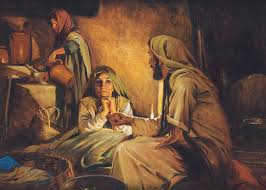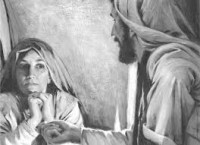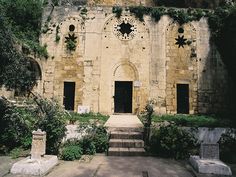
Sixteenth Sunday
-17 July 2022 –

Gospel Text: Luke 10:38-42
 vs.38 Jesus came to a village, and a woman named Martha welcomed him into her house.
vs.38 Jesus came to a village, and a woman named Martha welcomed him into her house.
vs.39 She had a sister called Mary, who sat down at the Lord’s feet and listened to him speaking.
vs.40 Now Martha who was distracted with all the serving said,
“Lord, do you not care that my sister is leaving me to do the serving all by myself? Please tell her to help me.”
vs.41 But the Lord answered,
“Martha, Martha,” he said “you worry and fret about so many things,
vs.42 and yet few are needed, indeed only one.
It is Mary who has chosen the better part; it is not to be taken from her.”
*******************************************
We have four commentators available from whom you may wish to choose .
Michel DeVerteuil : A Trinidadian Holy Ghost Priest, former director of the Centre of Biblical renewal .
Thomas O’Loughlin: He is on the theology faculty of Nottingham University
Sean Goan: Studied scripture in Rome, Jerusalem and Chicago and teaches at Blackrock College and works with Le Chéile Schools.
Donal Neary SJ: Editor of The Sacred Heart Messenger
*******************************************************
Michel de Verteuil
Lectio Divina The Year of Luke
www.columba.ie
General Textual Comments
Here is another very famous story which you must meditate on personally, letting yourself be guided by your feelings.
The passage has given rise to deep and sometimes mystical interpretations, but at root it is a simple story of human relationships and your meditation must start there.
You may like to focus on Jesus. See him as a model human being, receiving the hospitality of the sisters, accepting the love of Mary, teaching Martha wisdom, kindly but firmly.
Though the Catholic tradition has tended to favour Mary over Martha, some have found that Martha was in fact the more mature of the two. Identify with whichever of the two you feel attracted to, letting the other one be a lesson by way of contrast.
The key to the passage is the little phrase “the better part.” Your personal meditation will guide you in making your interpretation.
Scripture Reflection
 Lord, we pray for parents today.
Lord, we pray for parents today.
Let them not fall into the error of worrying and fretting
about doing many things for their children,
then complaining that no one is helping them.
Remind them that the only essential thing
is to sit down at the feet of their children and listen to them.
Lord, so often we keep busy, complaining about all we have to do,
and that our brothers and sisters are leaving us to do all the work by ourselves.
We even ask you to tell them to help us.
We thank you for that day when you sent someone to speak to us
– a sermon in church,
– one of our children told us we were insincere,
– we found ourselves committing a sin.
We felt hurt and angry
But now we realize that it was Jesus speaking to us as he spoke to Martha,
showing us that we really were running away
from the one thing we needed more than any other, to spend more time at prayer,
to sit at your feet and listen as you show us the truth about ourselves.
“The creator, the source of all, is in the heart of each one of us.” …The Upanishads
Lord, there is a Martha and a Mary within each of us
– a part of ourselves which is active and busy,
– another part which sits at your feet and listens trustingly to your word.
We need our active self to accomplish your will,
but the listening self is the best part,
and we must not allow it to be taken from us.
Lord, we thank you for listening communities,
–Bible sharing groups;
– alcoholics anonymous – all twelve steps programmes;
– Montessori schools.
What marks them out from others is simplicity.
Those responsible know that few things are needed to make a community,
and the one thing that must not be taken away
is listening to every member of the group as if sitting at the Lord’s feet.
“The West Indian people have not waited on governments; they have integrated in their own informal but highly effective way.” …Report of the West Indian Commission, June 1992
Lord, we pray for our leaders.
They worry and fret about many things, and even complain
that the people leave them to do the serving all by themselves,
when in fact they are neglecting the one thing that is needed most of all,
which is to sit at the feet of their people and listen to them.
*****************************************
Thomas O’Loughlin
Liturgical Resources for the Year of Luke
www.Columba.ie
Introduction to the Celebration
Welcome! Today we recall a small incident in the life of Jesus. Going along a road he came to a village and was welcomed into a house. There one sister, having to get the meal, complained that the other just sat and listened to Jesus; and Jesus says that this second sister, named Mary, ‘has chosen the better part and it is not to be taken from her’. This Mary is a model of discipleship for us. We are frequently busy with many things, but are we spending time listening to the voice of the Lord, are we reflecting on his wisdom, are we meditating on his goodness and wonder as we see it around us in the creation, are we recalling his gift of life, are we rejoicing in the presence of the Word made flesh?
Gospel Notes
This scene is found only in Luke, and is the story of one of a series of meals which are related in his gospel. Each shows the Christ with a different company, with a slightly different take on the nature of the welcome he receives from the householder and which he gives to those at table with him. For, while these meals always take place in another person’s house, it is clear that it is Jesus’s table: he is the host of the meal.
When this gospel was preached, the scene clues provided would have immediately made the audience recognise this as a meal of disciples and they would have read it eucharistically. This is not something that comes immediately to us for two reasons.
First, we have so developed the theological interpretation of the meal, that we fail to see the meal under the theology. Yet without the meal, there is nothing to be a sacrament of anything!
Second, we make a radical distinction — even when we are trying to study the early church — between the meals of the community and ‘The Eucharist’. But this distinct item of practice, along with its name, did not emerge until the second century. However, we still read the gospels as if only the Last Supper (and possibly Emmaus) relate to the Eucharist; while all the other meals are just informal settings so that Jesus could preach. This distorts Luke. For him to be a Christian disciple was to belong to the community and its common practices at the core of which was the weekly gathering at table in continuity with the practice of Jesus. In this gathering, the medium was the message. So every meal story was a teaching about the importance of being at the meal with the Lord.
It is from this perspective of the praxis of Luke’s audience that this text is interpreted in the homily notes. However, while the ‘message’ of this scene is tied up with the contrast between the actions of Martha and Mary, it should be noted that the traditional interpretation (going back to John Cassian) that it is the contrast between two ways of life, the active and the contemplative, is an imposition upon it from ‘spiritual’ interpretation. This is not a charter for a two-tier church, nor a plan for a pecking order between various religious orders in the church. The contrast concerns ways of behaving at the meal, and the reference to the ‘better share’ (meris) uses the exact same term used for the share (i.e. the broken parts of the loaf) each member of the community had in the Lord’s loaf.
Homily Notes
1. The scene in the gospel could not be simpler – it appears. Jesus happens to be going down a road and meets a village and accepts hospitality, there is some talk, and then, for the gospel teller, he moves on getting ever closer to the ‘centre stage’ in Jerusalem. But the early Christians froze this moment in their memories as something significant; and we have been recalling it ever since. Why?
2. Somehow this encounter was, for Luke, a vignette capturing something essential about Jesus. It somehow gave in a ‘snap shot’ something that was true of all encounters with the risen Lord. But how can we grasp the essence of this story and see how it might – as part of the kerygma – characterise our encounters with Jesus?
 3. The place to start is with the common elements: a village, a house, a meal, sitting at table, discussion. This is one more of these meal events – particularly prominent in Luke – that remind us that Jesus was ‘a party animal’. The meetings with those who were his followers and those who would listen are often shown to take place around the dining table. This was not just’ a quick bite on the way from work’ – his gathering of people around him at meals was at the very heart of the Lord’s work. To learn about Jesus and to be with him is to eat with him; and his meals model the perfect new community and offer a taste of the welcome of the Father in the final banquet.
3. The place to start is with the common elements: a village, a house, a meal, sitting at table, discussion. This is one more of these meal events – particularly prominent in Luke – that remind us that Jesus was ‘a party animal’. The meetings with those who were his followers and those who would listen are often shown to take place around the dining table. This was not just’ a quick bite on the way from work’ – his gathering of people around him at meals was at the very heart of the Lord’s work. To learn about Jesus and to be with him is to eat with him; and his meals model the perfect new community and offer a taste of the welcome of the Father in the final banquet.
4. We think of communities as ‘cities’ and churches as ‘parishes’ with hundreds of people. We usually think of our gatherings not being in a house – the ‘House Mass’ or ‘Station Mass’ is an increasingly rare phenomenon – but in special formal buildings called’ churches’ and then they are often built to fit hundreds. We tend to think of ‘getting Mass’, not of ‘sitting around the Lord’s table.’ And, we may see the table when we gather but we call it an’ altar’. Gathering for any meal around a table where we talk may be something done only rarely as we eat’ fast food’ or food off trays in front of a screen. So our gatherings do not immediately remind us of the meal in Martha’s house; and reading of that meal seems very distinct from sitting here on Sunday. Two factors create the separation: the first is sheer scale – we think of large groups and many such gatherings each Sunday; and second we use a language and a formality that obscures some of the basic shape of our encounter with the Lord at his supper
5. We should recall that for most of our history Christians have lived and worshipped in very small villages.

The Church of Simon Peter – Early meetings of the first Christians of Antioch were held here.
In an ancient city like Corinth the Christians would have had a village-like existence and met in groups of 50 at most, and so would have had a real meal experience. This is what Luke knows and experiences and what his audience knows and experiences. To meet for the meal/the Eucharist is the central act of the discipIes’ week as Christians. There they gather to be participants in the presence of the Lord as their welcoming host. There they share his food and his life and listen to his words. There the key is to be focused on the Lord – Mary – rather than focused on the mechanics of the meeting and the meal Martha.
6.The gospel today reminds us that the Word has become flesh, and he sits among us. He shares his table with us – the most basic human experience of welcome and sharing. We are disciples and sit with him and listen and learn from him so that we can grow to be fully-trained disciples.
7. Luke’s message today could be summed up as: To know Jesus is to eat with him.
8. There is always a surprise at Jesus’s meals: have you noticed this is a house that is owned by a woman? This is most unusual in the ancient world. Have you noticed that Jesus accepts women as full table companions – they can sit with him and talk with him? Again, not something that was at all usual in the ancient world. But Jesus broke down all the barriers to welcome at his table for that welcome was intended to show the welcome of the Father at the heavenly table.
********************************************
Sean Goan
Let the reader Understand
www.Columba.ie
Gospel Notes
That the incident in the house of Martha and Mary should follow immediately after the parable of the Good Samaritan suggests a possible connection. One aspect of Christian living is highlighted in the parable by the words ‘go and do likewise’. Being a disciple is not about ideas, it is about action.

However, the Martha and Mary story shows that sometimes the action can be misdirected and undertaken in a way that makes us lose sight of what really matters. We have to be careful here, because Jesus is not telling Martha that her work is not important, nor is he commending Mary for doing nothing. He is simply reminding his followers that if we want to serve him we must first listen to him — we need to be people of prayer before we can be people of action. Otherwise our actions can just be about us and it is possible to do good things for all kinds of bad reasons like,for example, our need to be needed or our exaggerated belief in the importance of our own contribution. Such behaviour can easily undermine the message of the good news which must always be about Jesus and his kingdom.
Reflection
‘The mystery is Christ among you.’ The word mystery is sometimes used as a way of avoiding having to work something out or even reflect on it. Paul, however, never used it in that way. For him Christ reveals the mystery of God, he does not hide it and so if we want to know God we must try to recognise the presence of Christ around us. As with Abraham in the first reading God may be coming to us as the one in need. If our hearts are not generous and welcoming, how often have we turned God away and in turn failed to experience the generosity he wants to bestow on us? Martha and Mary can also teach us something about recognising the Christ among us. They remind us that sometimes we need to ‘waste’ some time just being attentive, listening prayerfully to his words
If our hearts are not generous and welcoming, how often have we turned God away and in turn failed to experience the generosity he wants to bestow on us? Martha and Mary can also teach us something about recognising the Christ among us. They remind us that sometimes we need to ‘waste’ some time just being attentive, listening prayerfully to his words
*****************
4. Donal Neary S.J.
Gospel reflections for Year C: Luke
www.messenger.ie/bookshop/
Jesus and hospitality: God’s footprints
The half door on the old Irish house had many functions. It kept the animals out while allowing the family to look out. It also made for openness and hospitality for all who passed by. The traveller was welcomed and the one walking by could rest for a while. We were open to the world and the world to us, and we felt safe.
Hospitality was important in Jesus’ time. He made many a visit to the house of Martha and Mary, staying there when he wanted to go to Jerusalem. They enjoyed having him – Mary just sat there listening to him – the stranger, now a friend, who told stories of how life could best be lived. I can imagine him telling the parables in their house.
The people then had a belief in the travelling and pilgrim God, the one who came our way often.  The first reading is about strangers being entertained and the people didn’t know that the Lord was visiting them. When we open our heart and home to the stranger and to the neighbour we are receiving God into our lives.
The first reading is about strangers being entertained and the people didn’t know that the Lord was visiting them. When we open our heart and home to the stranger and to the neighbour we are receiving God into our lives.
The Indian poet Tagore writes – ‘and when you left I saw God’s footprints on the floor.’
 Our fear of break-ins and of robbery today is destroying an easy accessibility in our neighbourhoods. Casual hospitality is more difficult than in the days of the half-door. Maybe Facebook and Twitter and other social media fulfil some of this function, impersonal though it may be. We cannot live in isolation. ‘Self knows that self is not enough‘ writes the poet, Brendan Kennelly.
Our fear of break-ins and of robbery today is destroying an easy accessibility in our neighbourhoods. Casual hospitality is more difficult than in the days of the half-door. Maybe Facebook and Twitter and other social media fulfil some of this function, impersonal though it may be. We cannot live in isolation. ‘Self knows that self is not enough‘ writes the poet, Brendan Kennelly.
For friendship and love,
especially when I find it in unexpected places and people,
thank you, Lord.